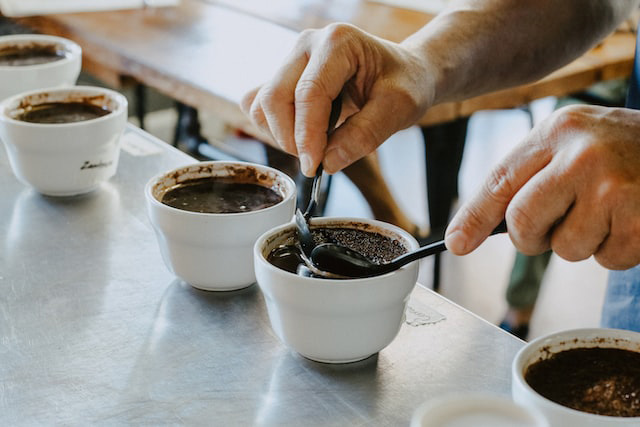What is cupping? Tasting and characterising coffee

Coffee tasting and appreciation can turn the simple act of drinking coffee into a richer experience. Drinking coffee and tasting it are two distinct acts, and through the practice of cupping, anyone can enhance their enjoyment of coffee. Whether you’re a coffee professional or a home enthusiast, there is no better way to understand and explore your passion than by developing your ability to examine a coffee’s unique characteristics in-depth.
Training the palate
Technically speaking, cupping is the traditional way to assess a coffee’s defects and to unearth its flavour profile. This is achieved through sensory evaluation and examination. All of the senses – look, smell and taste – are enlisted to determine the attributes of a coffee. In a cupping course we may cup and taste between four and six different origins with varying characteristics to cover a broad range of flavour profiles to evaluate and enjoy.
Cupping was first used by American coffee company Hills Brothers Coffee of San Francisco, in the late 19th Century. Traditionally, cupping has been the sole domain of those in the heart of the industry, such as roasters and green bean buyers. As a specialty roaster and trainer, we’ve been undertaking cupping classes for 17 years at Danes, but it’s only recently that cupping has entered the mainstream as baristas recognise the value of becoming more educated and knowledgeable.
A cupping session can be a formal endeavour, complete with a worksheet filled out and as a pre-purchase ‘inspection’, by a green bean buyer for example. It can also be something done by the specialty coffee roaster looking for ever more amazing coffee flavours coming from source. Regardless of the setting, the aim of cupping is to identify the taste characteristics of a given coffee.
Cupping 1, 2, 3
Firstly, you’ll need to decide on which coffees to evaluate. It’s best to consider starting with three or four. Sometimes the professionals will choose four or more different coffees from the same region to see how they compare. Choosing a group of coffees from different regions but which have similar taste profiles is another way to go when sourcing a specific flavour profile for a blend.
Precision is important in a cupping session, so it helps to have the right tools. It’s handy to have a set of bowls and spoons specifically for cupping. When using regular mugs or bowls, ensure that they are uniform in volume. You’ll also need freshly roasted coffee, a grinder, scales and a timer.
Begin by weighing each portion of coffee – we use 10 grams per cup. Distribute the coffee into individual cups. Start off by smelling the grounds and taking in the fragrance. Once the coffee is ready in each cup, pour 200 millilites of hot water (95 degrees Celsius) over the ground beans, making sure to saturate evenly. Wait three minutes, and with the back of a spoon, break the crust which has formed and stir. Make sure to take in the aroma that will waft up towards you. Remove the grinds from each cup using a spoon, rinsing the spoon between cups. Be careful not to cross contaminate any of the cups to prevent a flavour defect from passing over from one coffee to another.
Now the cupping session is ready to go full force. Using the cupping spoon (or a large tablespoon), scoop up the liquid and slurp it off the spoon. It’s important to bring air in while you taste, so some of the liquid droplets will enter the nasal passage. Flavor comes from the combination of smell and taste, and by enabling air to come into the back of your nasal passage, the olfactory bulb is activated.
Evaluating the elements
Begin to assess each coffee, one by one, making sure to rinse the spoon between each cup. Salty, sweet, sour and bitter are the four tastes we humans are able to experience, but there are other attributes to look for.
Things such as mouthfeel, or perceived thickness, and acidity, which is the tangy quality of coffee, can be observed. Is the aroma intense or mild? Other elements to consider are flavour, which is highly subjective and can range from chocolate to caramel to fruit. A coffee’s finish is also worth observing. Often during a cupping session, the participants will return to each cup when the coffee is cooling in order to determine whether a coffee holds its flavour.
A cupping session will often involve taking notes and giving a score to each origin. Using a cupping form is not essential; the main thing to consider is that cupping will ensure you are drinking coffee in a more mindful way. Detecting the subtleties of coffee takes time and practice, but the more you seek out the differences in look, smell and taste, the better you’ll become.
If you’re looking to get involved in a cupping session, there are roasters that conduct cupping classes. Cupping will provide you with the opportunity to learn about your palate and identify the subtleties of single origins and assess what the roasting process does to coffee. A cupping session is also a great place to learn about individual origins and the terminology used to describe the characteristics of coffee. After a cupping session, you are assured to become not just a coffee drinker, but a coffee taster.
Cupping is all about exploring, and with a resurgence of interest in Old School methods like pour over, immersion, batch and hybrids, why not try our Soft Brewing Principles & Practice.